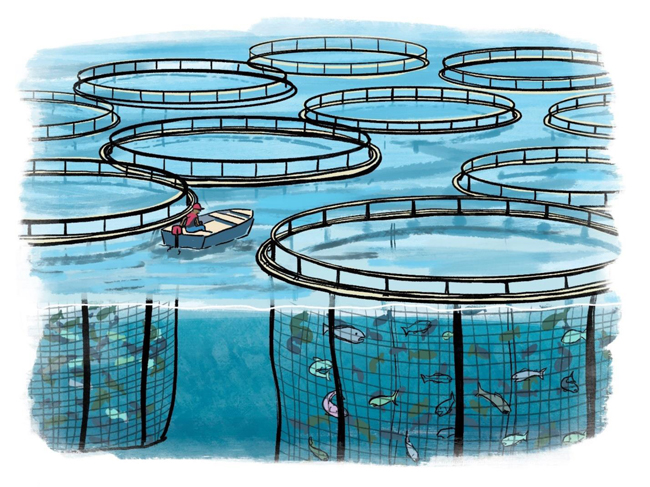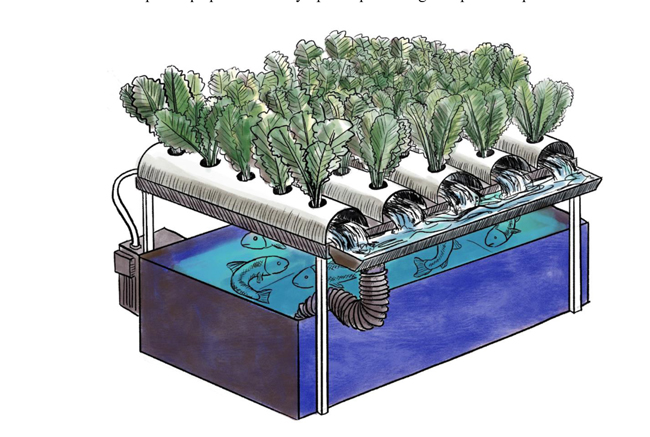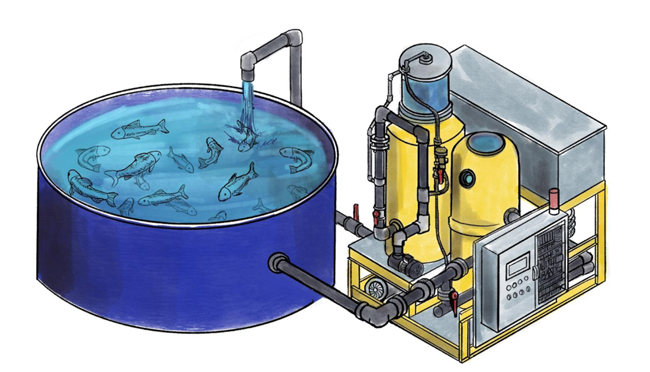— By Chris Gonzales, Freelance Science Writer, New York Sea Grant
Contact:
Barry Udelson, NYSG Aquaculture Specialist, E: bu25@cornell.edu, P: (631) 632-8730
NYSG’s updating of the New York Aquaculture Industry status report supports New York’s opportunity to become an industry leader
Stony Brook, NY, March 27, 2023 - A group of experts is hoping to give a boost to a healthful and potentially lucrative industry in New York State: safe, farm-raised fish and seafood.
The group has released a report [2022 NYS Aquaculture Report (pdf)] covering not only the historical roots of this up-and-coming industry, but an analysis of the current market situation.
The report covers the breadth of New York State, including lake, river, and marine environments. The report’s authors are academics and representatives from New York Sea Grant (NYSG), the Center for Aquatic Animal Research and Management, Cornell Cooperative Extension of Suffolk County, Lake Champlain Sea Grant, and Cornell University.

Net pens allow constant flow-through of surrounding water for cultured fish. As of 2021, New York does not have any near-shore or off-shore aquaculture farms. Credit: 2022 NYS Aquaculture Report, pg. 35
Responsible food source
Aquaculture is the practice of raising and harvesting fish, algae, and shellfish from both salt and freshwater environments.
When done responsibly, aquaculture is an environmentally sound way to source seafood, restore native populations, and even help maintain healthy ecosystems.
“Responsibly-grown aquaculture products provide New Yorkers and people around the world with an important source of dietary protein,” said Kathy Bunting-Howarth, associate director of NYSG. “The future of safe and sustainable aquaculture is bright if we take steps to support this practice.”

An aquaponics system can be used to grow vegetables and other plants as well as food fish. Credit: 2022 NYS Aquaculture Report, pg. 34
Developing an industry
On a global scale, the US is a minor aquaculture producer. The US imports between 70-85% of all its seafood, of which 50% is produced via aquaculture. The topmost imported products are shrimp, tuna, salmon, groundfish, and freshwater fish.
In recent years there has been a push by industry and government supporters to develop a strong, sustainable aquaculture industry in the US to increase local production and reduce dependence on imported seafood. As populations increase, a reliable and sustainable source of protein is needed.
New York has historically been a U.S. leader in aquaculture development, according to the report. But recently it has been falling behind.
This report offers some insights and ideas for entrepreneurs who may be envisioning what a turnaround might offer.

A recirculating aquaculture system keeps the water fresh and fish healthy. Credit: 2022 NYS Aquaculture Report, pg. 31
In the report
Among the historical and market data in the report:
• The Tunison Fisheries Lab, in Cortland, New York, was established in 1930 specifically to research trout nutrition and feed. It became a United States Geological Survey (USGS) laboratory in the 1970s. It’s been a key player in the reintroduction of lake herring and cisco, important prey for bigger game fish such as Atlantic salmon and trout. It’s also a lab, providing scientific research for restoration and protection of Great Lakes fish and habitats.
• The oldest fish hatchery in the Western Hemisphere, Caledonia Fish Hatchery, was started by Seth Green here in New York in 1864 to rear brown and rainbow trout for stocking. The state’s Department of Environmental Conservation (DEC) continues to stock game fish into New York waterways to support the vibrant freshwater angling industry. Private aquaculture operations also raise game fish but these producers sell their fish to private ponds and game clubs throughout the state.
• Recreational fishing brings in significant revenue to the state. Combined direct, indirect, and induced economic impacts of freshwater angling in New York State totaled an estimated $2.14 billion and supported 10,961 jobs in 2017.
• In recent years, due to a number of recurring harmful algal blooms (HABs) and the effects of a disease called QPX, hard clams have had a hard time surviving. QPX has wreaked havoc in the shellfish aquaculture industry all along the East Coast. Multiple Sea Grant programs, including NYSG, as well as researchers and industry have been working together to breed QPX-resistant hard clams for aquaculture and restoration.
• New York dominated the oyster industry in the late 1800s and early 1900s with a peak production of 25 million pounds of wild caught oyster meat in 1911. In recent years, oyster aquaculture has led New York’s cultivation efforts with 80% of its aquaculture revenue coming from oyster farmers.
So there’s a lot of history and current market analysis covered in the report, which supporters hope to see strengthen the industry by tempting new partners to explore it.
“The report is meant for policymakers, agencies, industry, growers, educators and those deciding about entering these businesses,” said Bunting-Howarth.
These new partners might be students looking for educational and job opportunities, or entrepreneurs looking to get into this field.
“A report of this nature is vital to the future of the industry because it provides guidance on how things were in the past and where they are now,” said Barry Udelson, aquaculture specialist for NYSG. “It summarizes the current issues so industry stakeholders can take appropriate steps to improve the industry without repeating previous mistakes.”
More Info: New York Sea Grant
New York Sea Grant (NYSG), a cooperative program of Cornell University
and the State University of New York (SUNY), is one of 34 university-based
programs under the National Oceanic and Atmospheric Administration’s
National Sea Grant College Program.
Since 1971, NYSG has represented a statewide network of integrated
research, education and extension services promoting coastal community
economic vitality, environmental sustainability and citizen awareness
and understanding about the State’s marine and Great Lakes resources.
Through NYSG’s efforts, the combined talents of university scientists
and extension specialists help develop and transfer science-based
information to many coastal user groups—businesses and industries,
federal, state and local government decision-makers and agency managers,
educators, the media and the interested public.
The program maintains Great Lakes offices at Cornell University, SUNY
Buffalo, SUNY Oswego and the Wayne County Cooperative Extension office
in Newark. In the State's marine waters, NYSG has offices at Stony Brook
University in Long Island, Brooklyn College and Cornell Cooperative
Extension in NYC and Kingston in the Hudson Valley.
For updates on Sea Grant activities: www.nyseagrant.org has RSS, Facebook, Twitter, Instagram, and YouTube links. NYSG offers a free e-list sign up via www.nyseagrant.org/nycoastlines for its flagship publication, NY Coastlines/Currents, which is published quarterly.